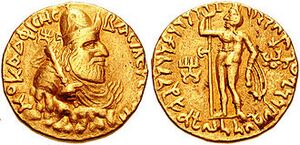Kadphises

Kujula Kadphises (30-80AD) (केडफाइसिज) (Kushan language: KOZOΛA KAΔAΦEC, Pali: Kujula Kasasa, Ancient Chinese:丘就卻) was a Kushan prince who united the Yuezhi confederation during the 1st century CE, and became the first Kushan emperor. According to the Rabatak inscription, he was the grandfather of the great Kushan king Kanishka I.
History
According to Thakur Deshraj Yuezhi people lived in north-west China. in 165 BCE there was a war of these people with with Hignu people in which Yuezhi were defeated and they moved to west in search of new lands. One of the groups of Yuezhi people was Kushan. Kujula Kadphises united all the five branches of Yuezhi and hence forth they were called Kushan. Thakur Deshraj says that Kushans were the people from Krishnavanshi, who moved with Pandavas in the great migration to north. The word Kushan has been derived from the sanskrit word 'Karshney' or 'Karshnik'. Kushan is nothing but Kaswan gotra found in Jats.
The rise of Kujula Kadphises is described in the Chinese historical chronicle Hou Hanshu: "More than a hundred years later (after their invasion of Bactria), the xihou ( "Allied Prince") of Guishuang (Badakhshan and the adjoining territories north of the Oxus), named Qiujiu Que (Kujula Kadphises) attacked and exterminated the four other xihou ("Allied Princes"). He set himself up as king of a kingdom called Guishang (Kushan). He invaded Anxi (Parthia) and took the Gaofu ("Kao-fu", Kabul) region. He also defeated the whole of the kingdoms of Puta (Parthuaia, 55 CE) and Kipin (Kapisa-Peshawar). Qiujiu Que (Kujula Kadphises) was more than eighty years old when he died." (Hou Hanshu, trans. John Hill).
In the process of their expansion eastward, Kujula Kadphises and his son Vima Takto seem to have displaced the Indo-Parthian kingdom, established in northwestern India by the Parthian Gondophares since around 20CE:
"His son, Yan Gaozhen (Vima Takto), became king in his place. He returned and defeated Tianzhu (Northwestern India) and installed a General to supervise and lead it. The Yuezhi then became extremely rich. All the kingdoms call their king the Guishuang (Kushan) king, but the Han dynasty call them by their original name, Da Yuezhi." (Hou Hanshu, trans. John Hill).
केडफाइसिस द्वितीय
ठाकुर देशराज लिखते हैं कि (भीम काषिणक अथवा भीम कपिशप त्रिदत्त) इसे चीन के साथ युद्ध करना पड़ा। इस युद्ध का कारण यह था कि इसने चीन की शहजादी से विवाह करने का प्रस्ताव भेजा था। चीनियों ने इसके दूतों का अपमान किया। इसने एक-एक करके पंजाब के कई यूनानी और शक राजाओं को जीत लिया। इसका राज्य उत्तर
जाट इतिहास:ठाकुर देशराज,पृष्ठान्त-203
भारत में बनारस तक पहुंच गया था। इसके पहले के राजाओं के सिक्के चांदी, तांबे या कांसे के हैं। इसने सोने के सिक्के प्रचलित किए। इसके सिक्के में त्रिशूलधारी शिवजी की मूर्ति है जिससे पता लगता है कि पंजाब के शिवगोत्री लोगों के प्रभाव से केडफाइसिस शिव का उपासक हो गया था। पेशावर जिले के पंजतार नामक स्थान से इसका सन् 64 ईसवी का सिक्का प्राप्त हुआ है। कहा जाता है इसके समय में रोम और भारत का व्यापारिक सम्बन्ध अत्यधिक था। यहां के रेशमी वस्त्र, जवाहरात, रंग, मसाले आदि की एवज में रोम से स्वर्ण आने लग गया था। मि. स्मिथ1 कहते हैं कि शक सम्वत् इसी ने चलाया था।
भीम केडफाइसिस के पिता के सिक्कों पर
- “कुजूल कसस कुषणाय बुगस ध्रमठिदस, कुशनस, युवस कोयुल कपसस सब ध्रमठिदस ”
और इसके सिक्कों पर
- “महाराज रजदिरजस सर्व लोग ईश्वरस महेश्वर सहिमकपिशष त्रिदत्त”
लिखा है। मोटे तौर पर इसका राज्यकाल 45 से 78 ई. तक माना जाता है। काशीप्रसादजी जायसवाल के मतानुसार मथुरा के अजायबघर में रखी हुई किसी कुषाणवंशी राजा के सिंहासन पर पैर लटकाए हुए बैठने वाले की मूर्ति इसी केडफाइसिस की है। मथुरा के अजायबघर में कनिष्क की भी एक खड़ी हुई मूर्ति है जिस पर उसका नाम खुदा हुआ है।
- 1. ‘अर्ली हिस्ट्री आफ इण्डिया’। पृ. 254
राजकीय संग्रहालय मथुरा में कुषाण प्रतिमाएं
राजकीय संग्रहालय मथुरा[1] भारतीय कला को मथुरा की एक विशेष देन है। भारतीय कला के इतिहास में यहीं पर सर्वप्रथम हमें शासकों की लेखों से अंकित मानवीय आकारों में बनी प्रतिमाएं दिखलाई पड़ती हैं।[2] कुषाण सम्राट वेमकटफिश, कनिष्क एवं पूर्ववर्ती शासक चष्टन की मूर्तियां माँट नामक स्थान से पहले ही मिल चुकी हैं। एक और मूर्ति जो संभवत: हुविष्क की हो सकती है, इस समय गोकर्णेश्वर के नाम से मथुरा मे पूजी जाती है। ऐसा लगता है कि कुषाण राजाओं को अपने और पूर्वजों के प्रतिमा-मन्दिर या देवकुल बनवाने की विशेष रूचि थी। इस प्रकार का एक देवकुल तो माँट में था और दूसरा संभवत: गोकर्णेश्वर में। इन स्थानों से उपरोक्त लेखांकित मूर्तियों के अतिरिक्त अन्य राजपुरुषों की मूर्तियां भी मिली हैं, पर उन पर लेख नहीं है[3]। इस संदर्भ में यह बतलाना आवश्यक है कि कुषाणों का एक और देवकुल, जिसे वहां बागोलांगो (bagolango) कहा गया है, अफ़ग़ानिस्तान के सुर्ख कोतल नामक स्थान पर था। हाल में ही यहाँ की खुदाई से इस देवकुल की सारी रूपरेखा स्पष्ट हुयी है।
See also
Reference
- http://en.wikipedia.org/wiki/Kujula_Kadphises
- "Catalogue of coins in the Panjab Museum, Lahore. Vol. I Indo-Greek coins", Whitehead, Argonaut Inc. Publishers, Chicago.
- Hill, John E. 2004. The Western Regions according to the Hou Hanshu. Draft annotated English translation
- Thakur Deshraj: Jat Itihas (Hindi), Maharaja Suraj Mal Smarak Shiksha Sansthan, Delhi, 1934, 2nd edition 1992.
- Dr Natthan Singh: Jat - Itihas (Hindi), Jat Samaj Kalyan Parishad Gwalior, 2004
Back to The Rulers
- ↑ राजकीय संग्रहालय मथुरा
- ↑ व्यक्ति प्रतिमाओं के विशेष अध्ययन के लिए देखिये: T.G.Aravamuthan, Portrait Sculpture in South India ,London, 1931
- ↑ C.M.Keiffer, Kushana Art and the Historical Effigies of Mat and Surkh Kotal, Marg, Vol 15, Number 2, March 1962, p.43-48

